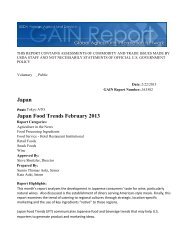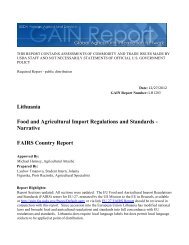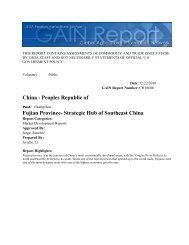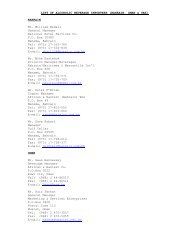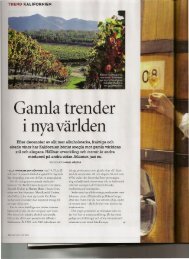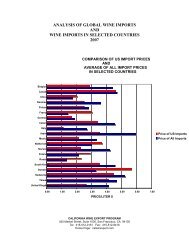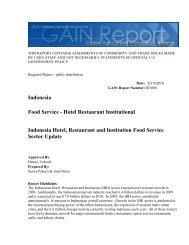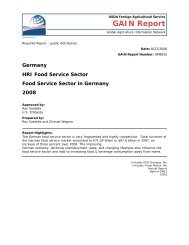Brazil Wine Market Report JBC EMP July 2011 - California Wine ...
Brazil Wine Market Report JBC EMP July 2011 - California Wine ...
Brazil Wine Market Report JBC EMP July 2011 - California Wine ...
You also want an ePaper? Increase the reach of your titles
YUMPU automatically turns print PDFs into web optimized ePapers that Google loves.
Government Production Policy<br />
10<br />
<strong>Brazil</strong>ian <strong>Wine</strong> <strong>Market</strong> <strong>Report</strong><br />
<strong>Brazil</strong> is fervently looking to wine production as a cash crop for their agriculture sector.<br />
According to the <strong>Brazil</strong>ian Institute of Geography and Statistics (IBGE) 2010 data, total<br />
vineyards planted in <strong>Brazil</strong> reached 83.718 hectares in 2010 up from 82.584 hectares in<br />
2009. In 1875 Bento Gonçalves, a town in Rio Grande do Sul, received Italian immigrants<br />
producing mostly American and hybrid grapes, more robust than vinfera varieties. The<br />
Italian arrival marked the beginning of expansion for <strong>Brazil</strong>’s <strong>Wine</strong> Industry. Today, Bento<br />
Gonçalves is considered the “<strong>Wine</strong> Capital of <strong>Brazil</strong>” primarily producing Cabernet Sauvignon,<br />
Cabernet Franc, Sauvignon Blanc and Merlot. In recent years, wine production in <strong>Brazil</strong> has<br />
generated greater wealth and employment, with the increase in grape growers and large<br />
wine processors. In the 1970’s, a multinational group of wine producers arrived in Rio<br />
Grande do Sul bringing with them modern wine-processing technology and planting new<br />
vinifera varieties although non-vinifera grapes still account for 80 percent of production.<br />
Isabella is the predominant non-vinifera grape and its juice production is an important<br />
export. In <strong>Brazil</strong>, table wine refers to non-vinifera and fine wine is the recently planted<br />
vinifera.<br />
Today <strong>Brazil</strong> is the 5 th largest wine producer in the Southern hemisphere with 320 million<br />
liters. Production in <strong>Brazil</strong> is highly concentrated in the southeast states. The state of Rio<br />
Grande do Sul alone accounts for 54 percent of all <strong>Brazil</strong>ian wine grapes produced. While<br />
there was an increase in vineyard planted areas in 2010, a combination of the global<br />
economic crisis and a poor harvest led to a 3.74 percent decrease in <strong>Brazil</strong>ian grape<br />
production when compared to 2009.<br />
Grapes production in <strong>Brazil</strong> (in tons)<br />
State/Year 2007 2008 2009 2010<br />
Pernambuco 170,326 162,977 158,515 168,225<br />
Bahia 120,654 101,787 90,508 78,283<br />
Minas Gerais 11,995 13,711 11,773 10,590<br />
São Paulo 193,023 184,930 177,934 177,538<br />
Paraná 99,180 101,500 102,080 101,900<br />
Santa Catarina 54,554 58,330 67,546 66,214<br />
Rio Grande do Sul 705,228 776,027 737,363 692,692<br />
<strong>Brazil</strong> 1,354,960 1,399,262 1,345,719 1,295,442<br />
Source: IBGE (<strong>Brazil</strong>ian Institute of Geography and Statistics)<br />
The table above illustrates the largest decrease in production took place in the Vale do São<br />
Francisco (Bahia state): 13.51 percent decrease from 2009, followed by Minias Gerais: 10.05<br />
percent decrease. The major wine producing region of Rio Grande do Sul realized a 6.06<br />
percent decrease in production.<br />
Presently in <strong>2011</strong>, climate issues are leading to an increase in grape production. Grape<br />
growers and wine producers have invested heavily in the industry, which has led to<br />
increased quality and efficiency in production. <strong>Brazil</strong>ian wine tends to be fresh and fruity<br />
with moderate to high alcohol content. The main grape varieties include Cabernet<br />
Sauvignon, Merlot, Moscato and Chardonnay (source: EMBRAPA). Because of its high quality



